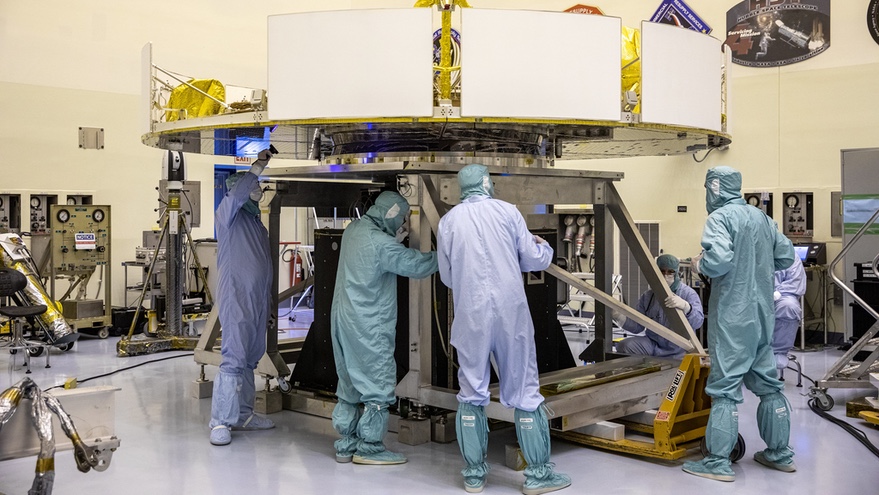LONG BEACH, Calif. — Future Mars lander missions could adopt less stringent planetary protection requirements by landing in regions of the planet unlikely to allow any terrestrial contamination to propagate, a study concludes.
The study by a National Academies committee, released Oct. 7, recommended that missions that don’t plan to go more than a meter into the surface could land across a wide range of lower latitudes of the planet unlikely to have large amounts of water ice.
“The committee’s findings can lead to making portions of Mars more accessible to both commercial and government endeavors by relaxing planetary protection requirements while remaining careful about access to potential habitable zones,” Amanda Hendrix, senior scientist at the Planetary Science Institute and a co-chair of the committee, said during a press conference at the annual meeting of the Division for Planetary Sciences of the American Astronomical Society, timed to the release of the report.
NASA commissioned the National Academies to carry out the study in response to a recommendation of a 2019 report by an independent review board. That report recommended NASA consider reclassifying regions of the moon and Mars to reduce the requirements on those missions while still limiting the odds of contamination to materials that may have evidence of past or present life.
“We want to avoid harmful contamination to preserve future life detection experiments on Mars,” Hendrix said.
The committee examined the factors that affect the survivability and transport of any terrestrial life that made it to Mars. The cold, dry conditions of the surface, along with ultraviolet (UV) and galactic cosmic radiation bombarding it, make it inhospitable. “The surface environmental is very biocidal, mainly due to the UV,” she said in a webinar Oct. 7 organized by the National Academies.
The concern is about transport of any terrestrial contamination below the surface, where it would be shielded from radiation and could access subsurface water, potentially in an interconnected network that would allow life to spread.
The committee concluded that this risk is mitigated if spacecraft operate in the top meter of the surface in regions that have only patchy water ice deposits or none at all. The one-meter limit, she noted in the webinar, is based on the limited data mapping subsurface water ice.
That would allow missions following reduced planetary protection protocols to land in much, but not all, within about 30 to 40 degrees latitude of the equator. Ice concentrations are greater closer to the poles, as well as in some regions closer to the equator. Missions that don’t plan to go below the surface at all could land anywhere on the planet using reduced protocols.
The report did not make a specific recommendation on what those new planetary protection requirements should be. The entire planet is currently classified as Category 4, the second-highest level of NASA’s planetary protection system, with stringent sterilization and “bioburden reduction” requirements.
“It was out of our charge to go in and say, ‘What do we mean by reduced bioburden requirements?’” Hendrix said at the press conference. “What we did say is that there do need to be some prelaunch cleanliness provisions taken by such missions.”
The report also recommended any mission landing on Mars under reduced planetary protection requirements steer clear of locations such as cave openings that give access to the planet’s subsurface. “We do have wind transport that can complicate matters,” she said. The report offered a conservative estimate of a buffer zone of 600 kilometers, based on wind speeds and how long a terrestrial microbe could survive on the Martian surface.
While the committee was offering recommendations for NASA, its members included a representative from ESA as well as people familiar with commercial activities. Joseph Alexander, a consultant who was the other co-chair of the committee, said in the webinar that he was hopeful the recommendations would be taken up by the Committee on Space Research, which oversees international planetary protection standards.
Implementing them for commercial missions is more difficult. “The problem today is that, in the United States, there isn’t a regulatory agency that has specific authority and responsibility to do that for commercial missions,” he said. “The U.S. government needs to resolve the uncertainty about how it will deal with commercial missions.”
The report only briefly addresses how this approach might be used for human Mars missions. “Given the underdeveloped nature of planetary protection policy for human missions to Mars, caution is necessary in addressing, even briefly, the suitability of applying guidelines for planetary protection for robotic missions to human missions,” the report stated.
“The current approach that has been effective in the past, which simply says, ‘you will not carry more than x number of microbes on your spacecraft to Mars,’ is very likely not applicable to a human mission,” Alexander said. “You can’t sterilize crew, for example.”
